
GROOMING FUTURE REVOLUTIONARIES
Woke Indoctrination at K-12 Schools on America’s Military Bases
Click here to view a PDF version of this article.
The American military is peddling critical race theory, white shaming, queer theory, and left-wing activism to children in its K–12 military schools.
The U.S. Department of Defense Education Activity (“DoDEA”), an agency under the Department of Defense, runs 160 schools on military bases across the globe serving more than 69,000 children of military personnel. It employs thousands of teachers. The DoD’s military base education budget exceeds $3.2 billion. This education system allows for easy transfer from one base to another, but it also allows for central command to dictate changes in curricular emphasis and direction. Tom Brady, the system’s director, created a new division for Diversity, Equity, and Inclusion (DEI) in 2021 to transform the educational experience in military schools.[i] Last year, DoDEA held an “Equity and Access” summit to guide common curriculum and practices for the military education system.

DoDEA pursues these goals in line with its 2018 “Blueprint for Continuous Improvement,” a strategic plan that guides the agency through 2023/24.[ii] Each of the core values in the agency’s “Blueprint” involves giving radical meaning to everyday language. One of the Blueprint’s core values is “trust,” which are relationships “based on integrity, mutual respect, and open two-way communication. We cultivate a safe and risk-free culture that encourages and inspires innovation.” In practice, however, this means that teachers try to undermine the trust students have in their parents through confidential communication and sharing naughty secrets that teachers will treat in a nonjudgmental way.
Another touchstone is “diversity,” which involves honoring “the uniqueness of each individual,” embracing “diverse beliefs and backgrounds,” and creating “inclusive environments.” In practice, however, diversity means an environment that shames white males while honoring supposedly oppressed groups.
DoDEA’s “Strategic Initiatives” emphasize DEI learning outcomes. Its first focus area, for instance, involves providing “equitable learning experiences for all students.” To achieve that goal, DoDEA “will implement programs and supports to address achievement gaps between racial, ethnic, ability, and other identified groups” and provide “learning environments where students feel safe, secure, and supported by the entire learning community.” The fourth focus area involves “Equity for Students, Employees, and Families.” To accomplish this, the DoDEA promises to “stand up and grow Diversity, Equity, and Inclusion (DEI) structures to lead and implement DEI across the organization so that all students, employees, and families feel welcomed, respected, engaged, and empowered.” None of the focus areas emphasize math, engineering, or academic excellence in general. “Key Performance Indicators” are appended to each of these focus areas, but these terms are not materially defined.
With the 2018 “Blueprint,” DoDEA fully dedicated itself to the woke agenda. This can be seen clearly in their teacher trainings. More than fifty presentations from the 2021 DoDEA conference were obtained through a whisteblower. The conference was explicitly completed in response to the DoDEA’s Blueprint agenda. All presentations were recorded and archived—and many came with accompanying lesson plans. Not all presentations, however, have been used to produce this report.
Cadets are increasingly subject to the full panoply of DEI at military academies.[iii] Now children of servicemen serving around the world are subject to the same woke education in their K–12 schools.[iv] Lesson plans are infused with cutting-edge left-wing pedagogical techniques in the service of radical gender ideology and white shaming/antiracism. The new military education aims to detach military brats from their families and their country, all the better to make them global citizens. It seeks to disrupt stable sexual identities. This education undermines justice, truth, and the American way of life. We wish to make clear that readers should understand what these ideologies involve—and how our military schools are peddling these ideologies—before we offer a full assessment of why these goals make for a mortal threat to our civilization.
Radical Gender Ideology
The radical gender ideology recommended for military schools is little different from that found in Portland, Los Angeles and San Diego.[v] Directions for implementing the radical ideology came from the 2021 summit talk called “Ally 101—Creating an Inclusive Classroom for LGBTQ+ Students” by Genevieve Chavez and Lindsey Bagnaschi. Chavez was a seventh-grade humanities teacher at David Glasgow Farragut Middle/High school in Rota, Spain, which serves the Spanish/American naval base there. Bagnaschi was a high school drama teacher at Stuttgart High School in Germany, which serves local army bases.
Many teachers are worried about peddling radical gender theories in the early grades, Chavez noted, out of respect for childhood innocence and parental rights. That notion is wrong: “You can talk about LGBTQ+ things in elementary school,” she argued; “It’s actually the ideal time.” She continued: “Kids as young as 4 years old are already starting to develop a stable understanding of their gender identity. So elementary school is the perfect time because you can really show students the diversity of gender expression and gender activity” (“Ally” at 43:23).

The presentation begins with a “Genderbread Person” activity, which teaches participants how to identify themselves on four continuums of gender, gender expression, biological sex, and sexual orientation. A child could have female organs but express gender in a male way by wearing pants or could claim a male gender and be attracted to girls. What would that person’s gender be? Finding out answers to this question is what education is! While Bagnaschi expressed reservations about this activity because it is too binary, taken as a whole it is “the best tool available for now” since it promotes a broad vision beyond the old idea of sex identity (“Ally” at 12:11).
Another option focuses on presenting students with subtle challenges to their self-understanding. The presenters recommended an activity for the first day of class intended to call into question the pronouns students use to refer to themselves and others (“Ally” at 18:03). Begin class on the first day, they suggest, by asking students their name and what they would like to be called. Depending on the answer, teachers should “dig a little deeper,” as Chavez says, by asking if the alternative name can be used in front of other students. “Maybe that student is not ‘out’ to other students in their gender identity,” she says, or “they may be out at school, but they may not be out at home” (“Ally” at 18:53). Schools are supposed to be a safe place where students can trust adults. Homes are unsafe and filled with deception. But it is not simply that teachers think themselves more qualified than parents; it is that teachers know parents would object to sowing gender confusion among their children. Parents have long taken for granted that cultivating a stable sexual identity is a key to individual development. Our military schools think upsetting a stable identity is the key to education.
“Ally” continues with the pronoun issue, which is coupled with attempts to build special relationships between teachers and children. They can keep secrets with one another. They must communicate with one another. “This might be the only place where they can truly be themselves and use their name and their pronoun,” Bagnaschi advised (“Ally” at 50:48). According to Bagnaschi, teachers should say their own pronouns whenever possible to “normalize” conversations about gender: “It’s modeling with the hopes that it starts some conversations” (“Ally” at 31:48). But sometimes teachers can forget, so Chavez recommends that teachers form little groups where they can practice student pronouns with one another, or they can ask the students to help police their language. One teacher, reports Bagnaschi, even has the students keep tallies of every time he “misgenders” someone. Every time he says, “ladies and gentlemen,” the kids mark it down. Sometimes Chavez herself calls the students “guys” instead of the gender neutral “seventh graders.” But the students help her overcome her prejudices.
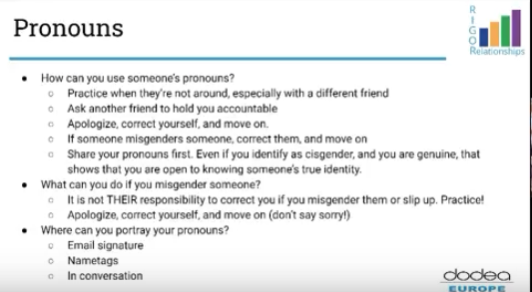
Bagnaschi tried to convince her students to abandon selecting a homecoming king and queen in favor of genderless titles like homecoming court or royalty. But the students unfortunately stuck to their benighted ways. “I really tried to push that this year with my junior class council saying, hey, why don’t we have ‘partners of distinction’ or some sort of thing that takes away from homecoming king or homecoming queen?” (“Ally” at 38:27). The kids resisted. But she will try again next year. Perhaps if the ground for gender confusion is better prepared, she can reach success. She is the tortoise, not the hare.
Other sessions provided guidance for building trust between teachers and students at the expense of parents as well. Michelle Nipper, a drama teacher serving the US Army Garrison in Bavaria, Germany, led one such activity in her talk, “Building Classroom Climate with SEL.” She recommended a game called “Cross the Line,” where students would stand on one side of the room and cross a line on the floor when the teacher made a statement that applied to them. Teachers would shout: “You know someone who has thought about or attempted suicide” or “You’ve felt alone or unwelcome” or “You feel homophobia is an issue in this school or community.” Nipper also
recommends gleaning personal information from students with daily prompts like “What does it mean to have a crush” and “What is something your parents don’t know about you?” (See “Building” at 17:40).
It is not uncommon in the history and practice of Western pedagogy to use “confusion,” so to speak, to cultivate student wonder and even philosophical eros. Students are much more motivated to learn when they know they are pursuing a deep question or trying to solve a puzzle. But for DoDEA presenters, the confusion is the whole point. They want students to puzzle over their own identity and even to create confusion where there once was certainty. Concern over gender confusion prevents students from ever discovering the wonder at the root of real education. Teachers want to see more children who are confused about their identity because only this confusion, in their view, is authentic. And then students are supposed to be fixated on that confused identity.
Moreover, students are supposed to become activists when it comes to restructuring the environment around them. Students become hyper-aware of misgenderings or pronouns. Students seek ways to make their environment less defined by the gender binary or by heterosexual norms. If students are used to restructuring their school environment, they will become activists for restructuring the general culture once they leave school. Future citizens, sons and daughters of military personnel, will become much more like their teachers than like their parents.
White Shaming and Antiracism
Whereas gender ideology starts with undermining parental authority, antiracism education begins with “courageous conversations,” imputations of privileged status, and making students feel uncomfortable. “REDI: First Steps for Leaders: Let’s Talk!,” for example, is a presentation that borrows heavily from the Southern Poverty Law Center’s “Let’s Talk” handbook about critical conversations.
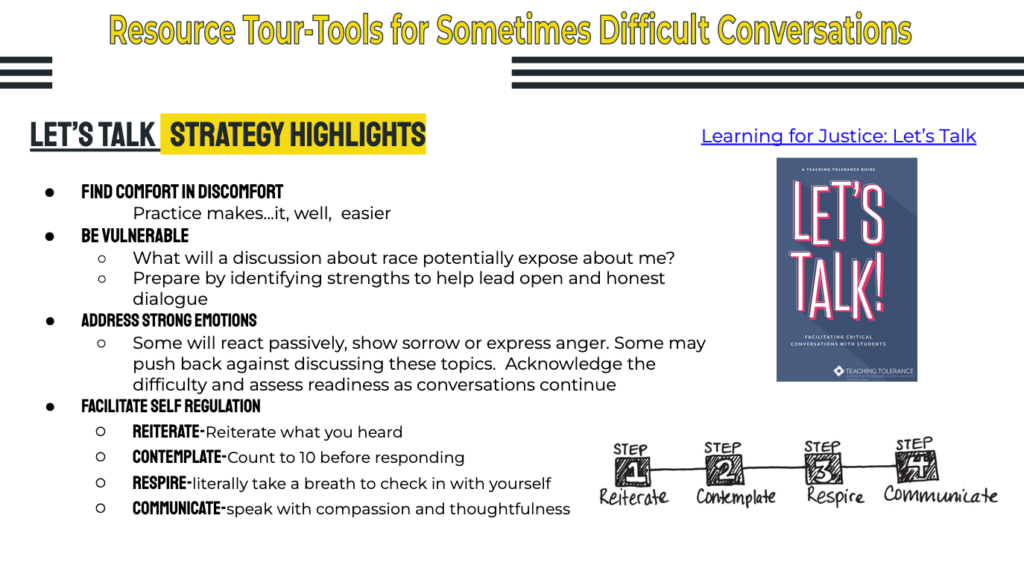
A critical conversation, according to the handbook, is “any discussion about the ways that injustice affects our lives and our society” or that “explores the relationship between identity and power, that traces the structures that privilege some at the expense of others, that helps students think through the actions they can take to create a more just, more equitable, world.”[vi] Another presentation fleshes out how such conversations could proceed. In “Be Well Do Well,” Caletha Ellis recommends questions like “what aspect of your racial or ethnic identity makes you the proudest?” and “Have you ever experienced a situation where your racial or ethnic identity seemed to contribute to a problem or an uncomfortable situation?” These courageous conversations replace the wonder that used to inform education.
These questions are all guided by the antiracism framework. Injustice affects every society, of course, but these presenters understand injustice only in terms defined by critical race theorists. Injustice means disparities between group outcomes—disparities to the disadvantage of favored minorities. Blacks suffer from some health problems at rates higher than whites, so DoDEA has a presentation on health equity— “We All Have Shoes: But Do They Fit? Health Education Equity”—as well as other areas of life where “equity” is an issue. The assumption is that structures of oppression and privilege cause these disparities. Several presentations thus insist that teachers “discuss inequitable structures and systems like privilege and racism” to reinforce this particular understanding of justice.
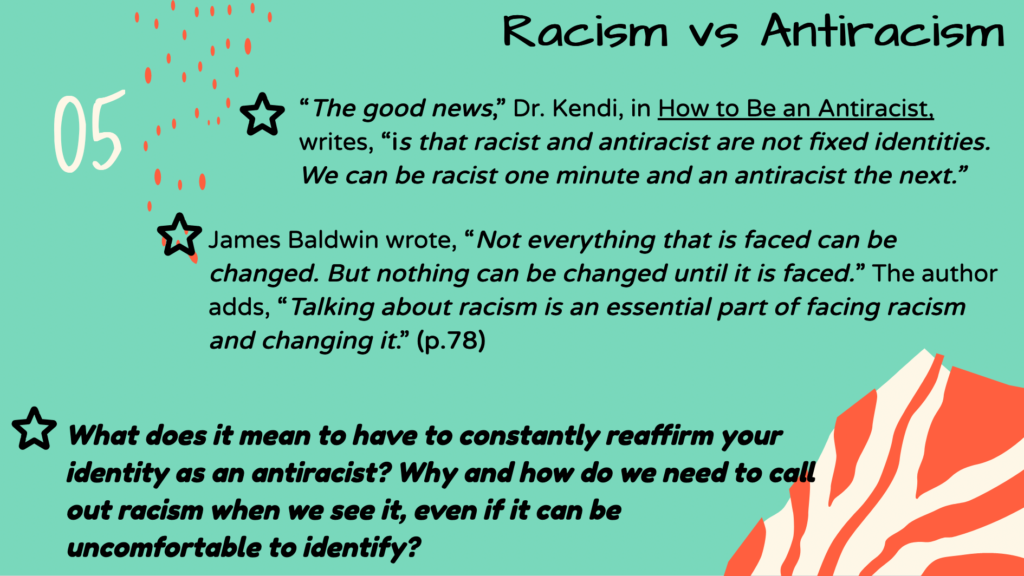
These courageous conversations are supposed to point students to lives of activism. The first strands of activism are seen very early—in the children’s books and activities that presenters recommend. Tracy Shelton, a literacy coach at Feltwell Elementary, which is attached to air force bases in Great Britain, recommends book studies as essential to learning the basics of antiracism and “ways to change” institutions and themselves. She reported on a training session she attended which encouraged the framing of people as either “racists” or “antiracists.” Racists, Shelton said, following the work of Ibram Kendi, are those who do not fight for racial equity, while antiracists put the fight for racial justice at the center of their lives. “It all starts with you, and your minute reactions, second reactions when you’re presented with difficult situations where you need to speak up or might not speak up” (“REDI for Change” at 7:3). Shelton suggested this distinction should guide student evaluation of the world and should be incorporated into class teaching. There are socioeconomic disparities between groups. Those disparities are traceable to structures of oppression like racism. Accepting those structures is racism. Racism is bad. Therefore, all good people must dedicate themselves to dismantling “racist” structures. All good white people must relinquish unearned privilege so that racism can be actively fought.
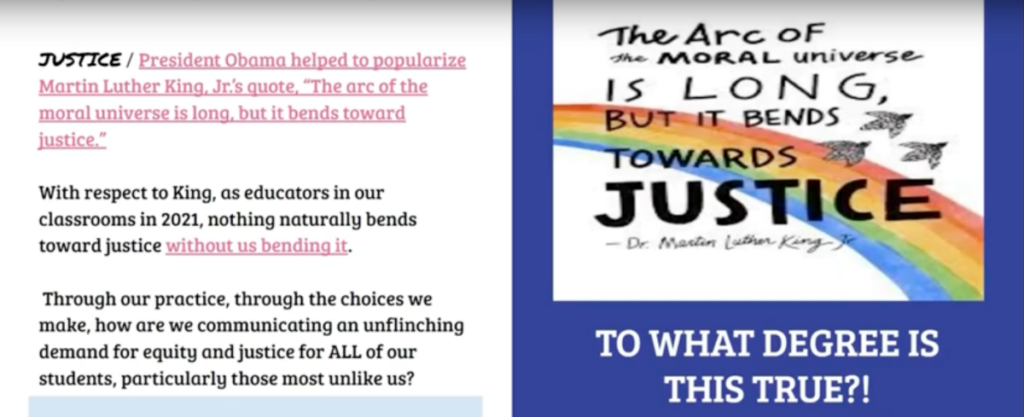
Antiracism can be practiced in countless ways. Interest groups galore have arisen to help teachers translate antiracism into the classroom and then beyond the classroom as well. In “Combating 1-Sided Narratives (Decolonize the Curriculum),” AP language teacher Gregory DeJardin, a Vicenza High School teacher serving at an army post in northern Italy, insists that teachers become activists themselves, since nothing naturally bends toward justice “without us bending it” (“Combating” at 8:18). Students react well to such an approach, DeJardin contends. A focus on inventors or discoverers, for instance, leaves students with a skewed view of the world, according to one of DeJardin’s students, since so many of the greatest American inventors have been white men. Emphasis on inventors is just “the American point of view.” Decolonizing the curriculum would either emphasize all the supposedly great minority inventors or stop focusing on inventors altogether, since the focus reflects supposed racial disparities in inventiveness. Bending the arc of justice requires a definite change in emphasis, if not a series of lies, noble or otherwise.
Decolonizing the curriculum is a nearly endless process, one especially present in efforts to change reading lists. Toward the goal of transforming reading lists, DoDEA sponsored several presentations, including “Responsive Academic Literacy” and “This is Us: An Elementary School Identifies Content and Practices to Promote Diversity, Inclusion, and Equity.” Equitable bookshelves could be found from several other book resources, including disrupttexts.org and socialjusticebooks.org, which feature books such as Rise Up: The Art of Protest and What We Believe: A Black Lives Matter Principles Activity Book. The “‘REDI’ for Change: Antiracism in Action” talk emphasized urging white people to confess their crimes of privilege and silence. “I was reading Me and White Supremacy,” said one teacher, and what it teaches “about white silence, and I realized the damage I was doing by my white silence” (“REDI for Change” at 10:10). Elementary school principal Michelle Woodfork also discussed changing the books students read in her presentation, titled “Embarking on Our REDI Journey.”
Teachers who cannot get a more radical reading list should use their academic freedom to integrate more radical readings, according to Merilee Debus’s talk, “Enriching Read Aloud and Independent Reading through the Use of Current and Diverse Children’s Literature.” Teachers “don’t have a lot of control over the texts that are chosen,” she complains, but they “do have some influence” over the books they choose “for read-aloud . . . independent reading, book clubs, literature circles. . . . We still have a lot of room for getting the right book in their hands when they need it” (“Enriching” at 7:50). Other teachers would subvert the chosen books by reading them with an antiracist lens. Betty Roberts of Robinson Barracks Elementary School, which serves five military bases in Germany, recommended teaching students to “take a look at their textbooks and [to] identify . . . the biases and how underrepresented groups are represented in these textbooks.” Her talk was titled “Critical Literacy: Analysis of Content, Recognizing the Hidden/Overt Bias that Precludes Equity and Equal Access and Adjusting Institutional Practices” (see “Video 1,” starting at 9:14).
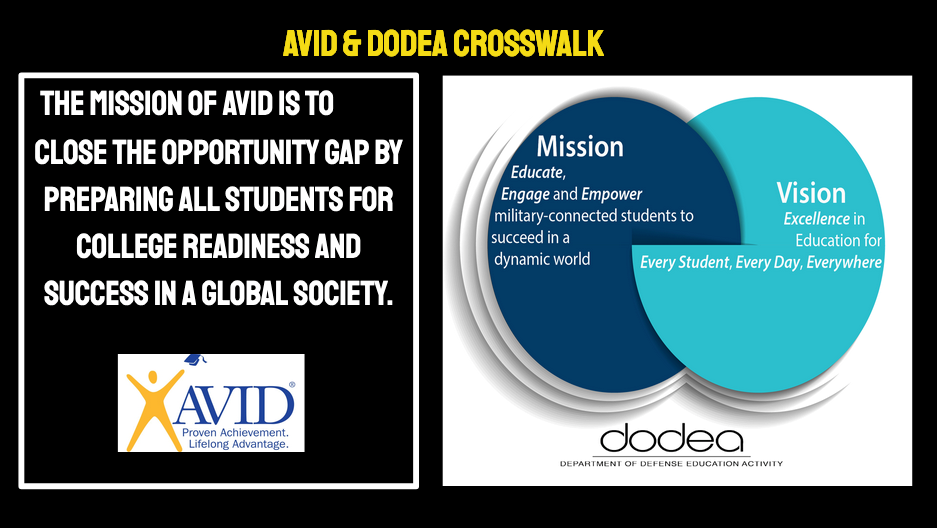
Antiracism policies take aim at the heart of the American way of life. In “Defining Characteristics of a ‘Brat’: What Social Science Data Say about the Military-Connected Child,” Shane Horn, another teacher, talked about the pushback against practices like singing the national anthem or saluting the flag that might connect the children of military service members. These symbols, it is claimed, are offensive to many identity groups. What, then, is to be done? The answer, partly articulated by Horn but fully embraced in other presentations, is to embrace global citizenship. Theresa King makes this argument in her presentation “Developing Equity through Education”: “Global citizenship education is a means to combat these ideas and practices.” Children will think their own country is fundamentally racist and in need of systemic change, but those kids can then become attached to a higher ideal than the nation—an understanding of humanity as such.
As another presenter (Tessa Wilson, in a talk titled “Can Second Graders Change the World?”) put it (quoting noted author Neil Postman), “schools don’t serve the public, they create it” (“Can” at 5:20). This new public will be less attached to the nation, which is fundamentally flawed. Instead, it will attach itself to the globe, engaging in activism that transcends borders and cultures and aims to cultivate a new religion of humanity. Students will hate parochialism and its associated phobias and -isms, while they celebrate global diversity and equity.
Lesson plans promoting antiracism, radical gender ideology, social justice activism, and global citizenship are common. Some lessons betray transformative social and emotional learning (SEL), a technique used to stigmatize old, supposedly oppressive ideas like the nuclear family, meritocracy, and color-blindness, and they replace them with radical notions like those according to which white people are inherently privileged or systemic racism. Other lessons use trauma-informed practices whereby teachers seek to manipulate the educational experience to produce more trauma and more stigmas. Teachers then use the trauma to upset comfortable relations children have with their families and friends and point them to activism and new opinions.
Radical Gender Theory and Antiracism Disrupt What Makes America Work
These ideologies undermine key American notions like color-blindness, meritocracy, and republican self-government. Critical theorists think that oppressive structures linger underneath our seemingly liberal framework. They therefore promote color-conscious and sex-conscious policies to students. Those from oppressor groups who achieve great things are stigmatized for having done them by unearned privilege. This cannot encourage their ambition and drive. And these ideologies encourage the transfer of government authority from representative institutions to government bureaucracies that will create the “equity.” Representative institutions are, after all, reflections of the people themselves and the people are oppressors. Only antiracist experts, for instance, can be trusted to examine the curriculum or to institute teacher training so the public does not overly taint the results. Only gender theorists can determine when someone’s identity is authentically chosen.
These ideologies foment social turmoil and antipathy. They teach that the oppressive structures and hostile attitudes of one group for another are sown into the nature of human life. If they cannot be overcome, there is no way out of the treadmill of oppression: it is only a question of who is on top. The liberal concepts of color-blindness and merit have been used to tame tribal tendencies in human nature, but these concepts are thrown out with antiracism policies.
These ideologies undermine attachment to our nation. Teaching that America is inherently racist or systemically racist is a big lie. No good results can proceed from such a lie. America is a land of hope and a land of promise. Undermining attachment to the country, based on lies or half-truths, will undermine the country in the long term.
These ideologies undermine America’s competitive advantage in education. The traditional view of education sees a school’s mission as imparting objective, academic knowledge and skills to students while cultivating civic friendship and responsibility. The new view of education uses schools to teach children how knowledge is subjectively built on power and privilege. Traditional education values individual merit while the new education stigmatizes achievement and rejects individuality in favor of group identities. Traditional education seeks to cultivate students’ minds for their own sake while the new view trains students to become activists for the political cause chosen by teachers. No wonder test scores are cratering across the country.
These ideologies undermine traditional family life. Traditional education views character formation as only a supporting role complementing the work of families, religion, culture, and other institutions and relationships in American life. The new education intrudes into family life by limiting the power of parents and by teaching children to avoid starting a family. Traditional education respects parental rights to decide where and how their child should learn, but school districts overtaken by this new critical social justice education believe parents have no right to dictate what schools teach their children. These ideologies strip away the delineation between private and public life in schools. Proponents know that a stable American society based on family life, parental rights, and child protections will not produce radicals.
These ideologies lead to further extensions of state power. Under a school system taken by such a vision of education, the state alone determines what children learn to be good, true, or beautiful. Practices such as white shaming or the sexualization of children are intentional pieces of a broader plan. Childhood innocence and family stabilizations are roadblocks to revolution. But sexualizing children will lead to the creation of a gender fluid society that normalizes sexual deviancy. The line between childhood and adulthood will be erased. “Equity” is more easily achieved. The racial shaming of children will lead to a culture of victimization and group rights antithetical to freedom of speech and equal treatment under the law. “Diversity” and “inclusion” can be accomplished. This sexual and racial exploitation cultivates anger, resentment, and hatred in children. The next generation will grow up to be radical adults resentful of their parents’ norms and religious values, and ripe for the political change the new educators seek.
A Call to Action
Public officials must reinstate the inalienable authority of parents in family life to direct their children’s education and care if we are to stave off these disasters. A traditional education model of objective truth and human dignity must be regained. Parents must stand up against an ideology that has gained so much power in schools.
Senator Marsha Blackburn (R-TN) proposed amendments to the DoDEA in the National Defense Authorization Act in June 2022, and Representative Elise Stefanik (R-NY) sought to get a service member parent bill of rights through the House.[vii] Both efforts sought to establish a parents bill of rights, of sorts, for military parents, one that includes the “right to review curriculum” and “the right to review all instructional material” among other things. Neither proposal established educational alternatives for service members, something available to those serving the State Department overseas. Neither proposal, however, got anywhere.
Furthermore, it seems that members of the military who object to such education are no longer welcomed in the military. Perhaps they should just walk out of the military schools with their children or walk away from the military altogether. All branches have fallen short of their recruiting targets in recent years, and perhaps part of the reason for this concerns the way the military increasingly conceives of the country it is built to serve. Having Congress use the power of the purse is essential to any decent reform. If the military has direct power to impose these ideologies on its K-12 schools, Congress surely has the power to reshape how the military uses its money and power. Responsible lawmakers who want to preserve America and the American way of life should use their authority over the funding of the military (and military schools) to stop and reverse this dangerous and revolutionary educational system. It is bad enough for civilians. It is even worse for our military families. It is completely unacceptable to corrupt the children of those serving in the military to subject them to anti-American, antifamily hatred in the name of perverse, dangerous, and false ideologies.
[i]. “Diversity Equity and Inclusion,” DoDEA, https://www.dodea.edu/offices/dei/index.cfm.
[ii]. “Blueprint for Continuous Improvement,” DoDEA, July 2022, https://www.dodea.edu/blueprint/upload/blueprint-volume-iv-2022-july.pdf.
[iii]. Rod Dreher, “Wokness Comes to West Point,” American Conservative, July 9, 2020, https://www.theamericanconservative.com/social-justice-warriors-antiracism-wokeness-comes-for-west-point/
[iv]. Meg Kilgannon, “Are DOD Schools Fit for Service?” Family Research Council, April 12, 2022, https://www.frc.org/updatearticle/20220412/dod-schools.
[v]. Christopher F. Rufo, “In Portland, the Sexual Revolution Starts in Kindergarten,” City Journal, May 27, 2022, https://www.city-journal.org/in-portland-the-sexual-revolution-starts-in-kindergarten; Christopher F. Rufo, “Sexual Liberation in Public Schools,” City Journal, July 20, 2022, https://www.city-journal.org/sexual-liberation-in-public-schools; Christopher Rufo, “The Dismantlers,” City Journal, August 3, 2022, https://www.city-journal.org/san-diego-schools-gender-extremism.
[vi]. See “Let’s Talk! Facilitating Critical Conversations with Students,” Teaching Tolerance, https://www.learningforjustice.org/sites/default/files/2022-09/LFJ-Lets-Talk-September-2022-09062022.pdf, p. 2.
[vii]. Kelly Laco, “Sen. Blackburn’s Plan to ‘De-Wokeify’ the Military Foiled by Democrats,” Fox News, June 17, 2022, https://www.foxnews.com/politics/blackburn-plan-dewokeify-military-foiled-democrats; Brooke Singman, “Stefanik Rolls Out ‘Bill of Rights’ for Service Member Parents to Ensure Transparency in DOD Schools,” Fox News, June 23, 2022, https://www.foxnews.com/politics/stefanik-rolls-out-bill-rights-service-member-parents-ensure-transparency-dod-schools.

 Twitter
Twitter
 Facebook
Facebook